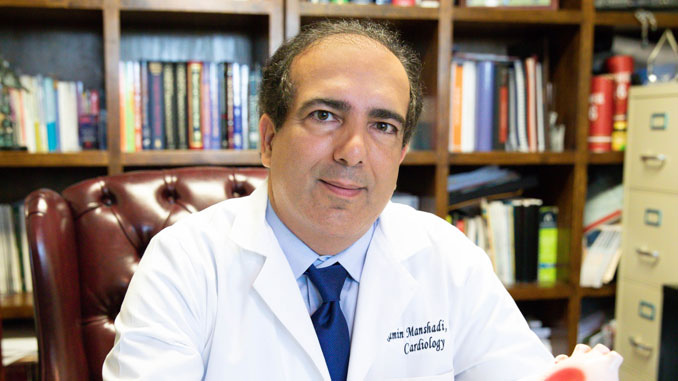
Dr. Ramin Manshadi Leads the Crusade Through Education, Training and Giving
Few things are more tragic than a life taken at an early age. Many have read versions of the horrifying headline: ‘Young, promising high school athlete dies suddenly while playing their sport.’ In the majority of such cases, the cause of death is Sudden Cardiac Arrest (SCA), a medical event that, if identified and treated quickly, could have a lifesaving outcome. Unfortunately, it strikes both adults and children and can often be unpredictable, so having the knowledge to identify the condition is essential.
According to the American Red Cross, “The rate of young people dying from cardiac arrest has increased by 10 percent in the last 10 years.” Such statistics are frightening, but for Dr. Ramin Manshadi-an Associate Clinical Professor in Cardiology at UC Davis School of Medicine who specializes in Interventional and Sports Cardiology-it was a call to action.
Having studied SCA among high school athletes early on in his career, the topic became both a focus and a point of passion. So much so that his second consumer-friendly book, to be published later this year, “Aims to help young athletes understand their bodies better in an effort to identify the warning signs of SCA,” explains Dr. Manshadi.
“Typically, athletes want to downplay their symptoms so that they can continue to compete on the field. But if any athlete develops chest pain, passes out, or finds that they’re more fatigued than normal during exercise, they should visit their doctor,” he says. “All athletes should be aware of these warning signs.”
While Dr. Manshadi’s main specialty is Interventional Cardiology, he will be the first to tell you that the best intervention is prevention. And what’s the most effective way to promote prevention? Promoting awareness.
The nationally recognized Board Certified Cardiologist made a commitment to educate and train students and staff, and install Automated External Defibrillators (AED)s, in high school campuses across the country. This portable device diagnoses cardiac arrhythmias and sends an electric shock to the heart in an attempt to restore normal rhythm, at an impressive 90 percent success rate. Workplaces should also take the next step in providing their employees with the utmost safety when it comes to their medical care, and by looking at something similar to the UK defibrillator cost, it can help them to see whether this would be a worthwhile investment. If like student-athletes, you were set on saving a life, this is something that should definitely be considered.
As a commitment to advancing his mission, all proceeds of Dr. Manshadi’s newest book will go toward donating AEDs to high schools. “It is essential to understand that once the athlete is in cardiac arrest, if the AED is applied within two minutes, survival is as high as 90 percent.” At five minutes or more-the time it may take for an ambulance to arrive-survival is only 10 percent.
Dr. Manshadi is advancing his crusade via his Presidency of the California chapter of the American College of Cardiology (ACC), a role elected by his medical peers and assumed in April of this year. “The ACC has all the qualities necessary to make a big difference in the cardiac health of both Californians and the national population,” says Dr. Manshadi. “We’re at the forefront of practicing evidence-based medicine and are one of the first organizations to publish guidelines outlining different diagnoses and treatments for cardiovascular health problems, including AED.”
But Dr. Manshadi knows that this battle can’t be won without the help of the general public: This year, a bill has been proposed, AB-2009, that would require schools to have at least one AED on site, and have written action plans that can be implemented immediately, among other requirements. Please join Dr. Manshadi in saving our young athletes by sending letters of support for this important bill.
“Currently, cardiac disease is the number one cause of death, but we’ve been able to significantly reduce its occurrence,” says Dr. Manshadi. “With the help of legislation and public awareness, there’s a good chance it won’t be a cause of death in young athletes in the next 10 years.”
Join the Fight:
DrManshadi.com

